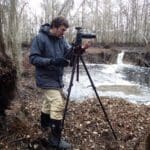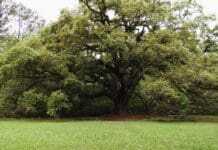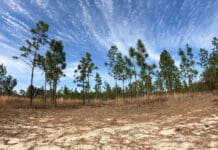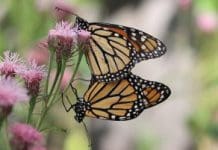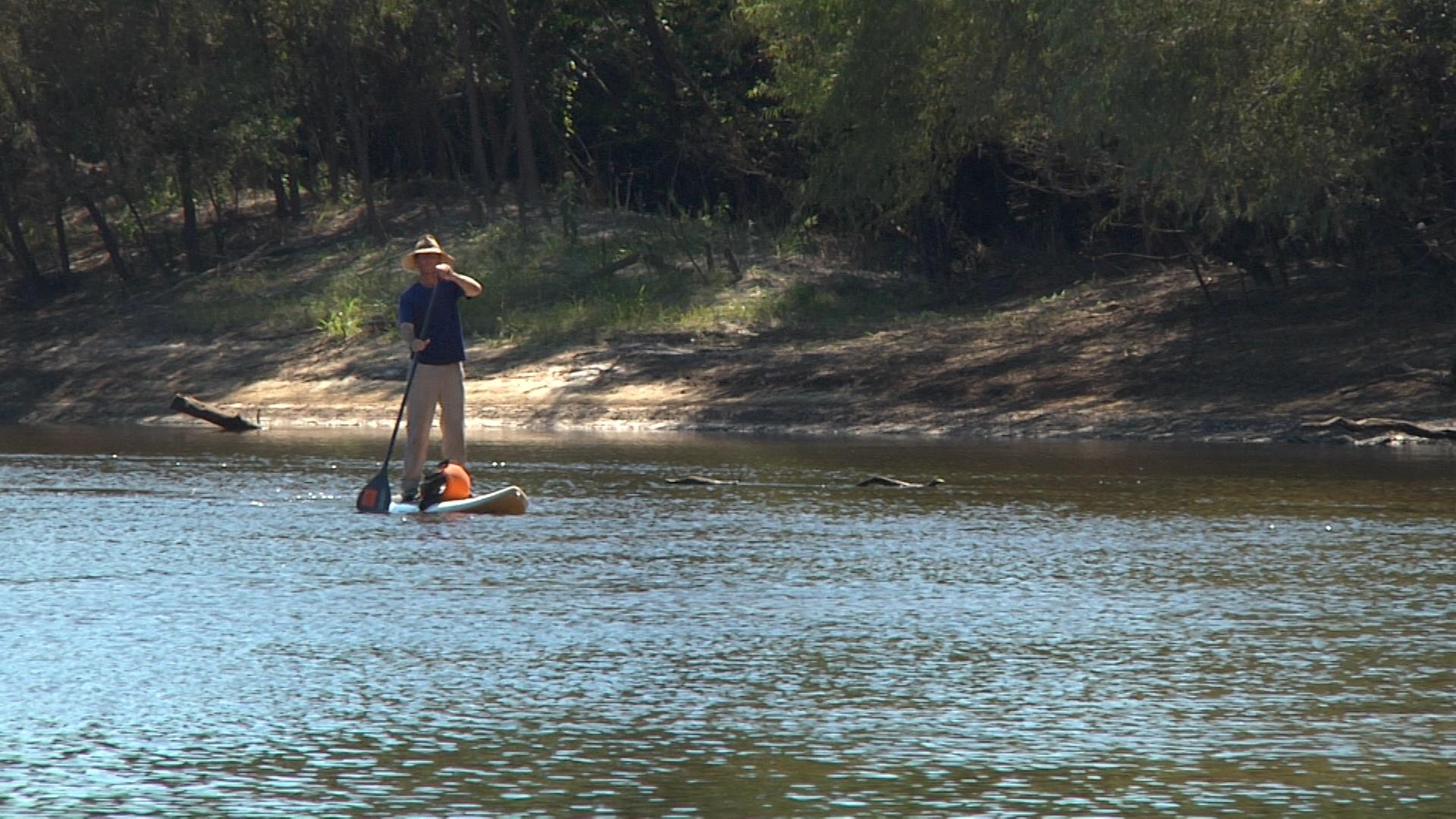

“We’re lucky in this area… and maybe we don’t always realize it because we do have so much of our native ecosystem left, with the Red Hills plantations that have been maintained with fire for many years – places like this, that have been protected from development.” Joe Burnam is on the Board of Directors for the Lost Creek Forest. “From an indigenous standpoint, from a Native American standpoint, areas like this were important. Just like those of you that are hunters nowadays, you know that critters like to live where there’s edge, where there’s different habitat types that come together. This is a natural edge between the frequently burned uplands and the bottomlands.”
Lost Creek Forest in Thomasville, Georgia gives us a glimpse of what forests looked like before European settlement and may also give us an insight into the people who lived here.
Native plants and animals were often used for important items like clothing and rope. Take the yucca plant as an example.
Joe Burnam demonstrates to an avid group of children and adults how a bowstring could be made using the leaves of the yucca. He lays the leaf over his knee and scrapes it until only the stringy fibers are left. Then he shows how much easier twisting the fibers can be if the ends are placed in the mouth and both hands are used for twisting it. Yucca is one of the many plants that make Lost creek biologically unique.
To members of the community, it’s an ecosystem worth saving. Just ask Beth Grant, who is the Founder and President of the Lost Creek Forest. “It’s really a special remnant of what the natural landscape was like before the Europeans came. In 2008, there was a plan to turn this into an industrial park, and we had a grassroots movement. In five weeks we did just an amazing organizational job and convinced the county not to sell it for that purpose.”
As the group wanders through the forest, Joe Burnam and Beth Grant point out other plants along the way, like the partridge berry, which is a native plant and a good indicator of relatively undisturbed areas.
Ms. Grant explains “This was one of the two vines that the botanists all said was this was an old growth, non-disturbed forest because they wouldn’t be here in this quantity. In the old growth, the community has been growing and changing on its own over the millennium, and anything that’s been cut or certainly farmed and plowed and that kind of thing… it just will never be that same way.”
Lost Creek is one of the main headwaters of the Aucilla River, which flows from Thomas County all the way down to the Gulf of Mexico. A similar slope forest property was saved in neighboring Grady County. Where Lost Creek feeds the Aucilla, Wolf Creek feeds the other main Red Hills river, the Ochlockonee.
Beth Grant says “Wolf Creek is so unique. I mean, we don’t know that there’s that many trout lilies anywhere in the world, certainly of that species, and here it is in south Georgia where it doesn’t even really, quote “belong”.”
Over on the Ochlockonee River, a group of students in kayaks navigate turns and deadfalls. It’s not your usual field trip. These students from Thomas University are gathering geographic information to make maps for a paddling trail being developed in Georgia. Margaret Tyson started the Ochlockonee River Water Trail project two years ago. Dr. Christine Ambrose, who is the Director of the Geospatial Analysis and Planning Lab at Thomas University saw the water trail as a wonderful opportunity to use it for a geographic information system and thought it could be a great contribution to help them jump start mapping the trail.
Margaret Tyson explains “Part of our mission today is to recon this portion of the river. We’ve actually run into some deadfall, and that’s one of the things we want to identify today… this is part of it right here. The wild adventure of the Ochlockonee!”
Student Braxton Hicks marks blockages using a GPS. There are a lot of them, so he’s been busy.
In addition to mapping, the group also clears some snags to improve navigability. A trip like this can be fun if you’re not in a hurry – and it lets you get to know the river and the land around it.
As she paddles, Christine Ambrose talks about this piece of the river. “On this side of the river is a conserved piece of land called Deerwood Plantation. And as we paddle down to the south, we’ll be then connecting with another easement on Mistletoe Plantation. Having this land undeveloped and conserved definitely helps with erosion. It’s natural water quality filtration. It’s a natural corridor for wildlife. It’s… It’s excellent.”
On another part of the river, another group of people, including a number of children, are looking at the various animals that live in the area. Kim Sash is a Conservation Biologist with Tall Timbers Research Station and Land Conservancy and today, she’s in charge of the first ever Ochlockonee River Bio-Blitz.
“Basically, all we’re trying to do is just go out and catch as many species as we can. We know there are about a hundred and seventy species that are endemic to this area of the Southeast, so we’ll be trying to highlight some of those today and bring attention to the river too, because in Florida, it flows through a lot of natural areas, but in Georgia it flows through a lot of agricultural land so we want to bring attention to it and make sure it stays clean.”
Georgia’s Ochlockonee River collects pollutants from farms, wastewater treatment facilities and industrial sources. Fortunately, the worst of it stays behind the Jackson Bluff Dam. Today’s Bio-Blitz is just south of the dam in the Apalachicola National Forest.
Kim Sash continues her thought, “and it also feeds that huge marine estuary down there, which is really important for Florida’s seafood industry.”
The group uses a seine to catch some specimens from the river and use a book to help identify what is brought up.
Rebeca Zeroth is helping with identifications. “That one, we think it’s a Seminole killifish. You can see kind of lines on the side and it has that reddish-orangey kind of fin right there,” she says, pointing out the features to some of the children gathered around.
Pierson Hill is a Biological Scientist for the Florida Fish and Wildlife Conservation Commission, and he lends his expertise to help identify species and to do a little education as well. “Most turtles, you know, have a hard shell,” he says as he holds up a rather large turtle. “These have a soft shell, but what they lack in armor they make up for with jaws and claws.”
Kim Sash sums it up… “You know, this river has a lot of facets to it. A lot of different parts, which makes it really cool – and we just want to get it on people’s radar as something that we need to really enjoy, as we did today, but also take care of and keep clean.”
To read more about this, visit WFSU\’s Ecology Blog.
Rob Diaz de Villegas is a senior producer for television at WFSU Public Media, covering outdoors and ecology. After years of producing the music program OutLoud, Rob found himself in a salt marsh with a camera, and found a new professional calling as well. That project, the National Science Foundation funded "In the Grass, On the Reef," spawned the award-winning WFSU Ecology Blog. Now in its tenth year, the Ecology Blog recently wrapped its most ambitious endeavor, the EcoCitizen Project.
Rob is married with two young sons, who make a pretty fantastic adventure squad.

